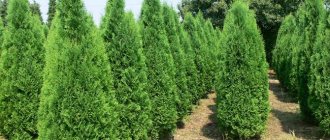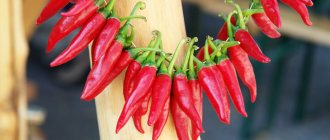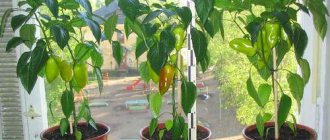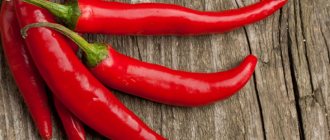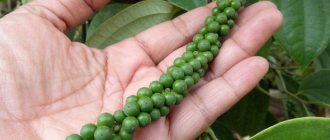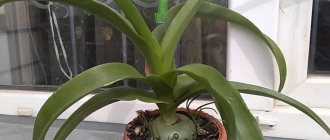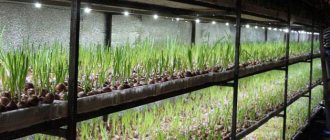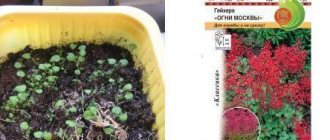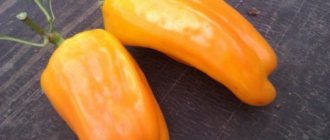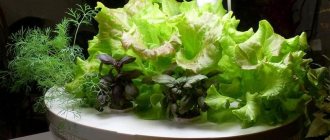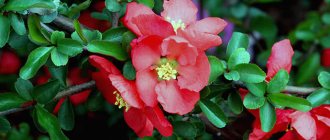Chili pepper is the most popular spice among “spicy” lovers. It is used not only in cooking, but also in medicine or cosmetology. The benefits of the plant were well known to the Aztecs and Mayan tribes - Europeans received the first seeds from these peoples.
Today, even a beginner can cope with growing peppers: beautiful bushes will become a good decoration for a balcony or windowsill and will certainly delight their owner with sharp, piquant fruits.
Choosing a pepper variety to grow on a windowsill
It is not difficult to grow chili peppers at home on a windowsill if you choose the right variety.
Exotic names of pepper: Swallow, Bell have different shapes, fruit color, leaf color and ripening period.
Early ripening varieties ripen in 90-120 days, mid-ripening varieties in 120-140 days from the moment of planting.
The Tabasco variety has hot fruit pulp. Suitable for growing on a window, and for industrial purposes - on plantations. Pepper is valued for its early ripening.
Salute is a low-growing variety, its compact round bush grows up to 20 cm. Five-centimeter fruits in the form of orange and red cones are directed upward and have a strong aroma.
The Aladdin variety is grown on a windowsill or in open ground. During the growing process, its fruits change from green to flint, purple and red. Pepper is distinguished by its long and abundant fruiting, as well as its early ripening.
The bell has red fruits of an unusual shape; the variety ripens in 150 days. The pungency in the fruits is unevenly distributed.
Other early ripening varieties for growing at home are also popular:
- Dwarf;
- Watercolor;
- Treasure Island;
- The firstborn of Siberia.
On a note. There are also inedible types of peppers that are grown only for decorative purposes: Red Rocket, Pepperoni, Orange, Clown, Filius Blue, Goldfinger.
Botanical features of hot pepper
A relative of sweet pepper blooms inconspicuously, but bears fruit extremely impressively. The flowers are similar in appearance to potato flowers, but in some hybrids they have a bright rim along the edge of the petals. This is not surprising, since hot peppers belong to the large nightshade family.
During the fruiting period, the bush is decorated with small, smooth, as if varnished, fruits. Depending on the variety, peppers are red, orange, yellow, sometimes white and even purple. Because of its beauty and abundance of fruit, bitter pepper is also called Christmas pepper. Outwardly, it really looks like a Christmas tree.
Peppers differ not only in color, but also in shape: some, like New Year's toys, are round; others hang down like bells; and still others rush upward like candles. And they are all edible! The level of ripeness influences the severity: one bush may contain unripe fruits with a piquant taste, as well as extremely spicy, already ripe ones.
The component that gives pepper its heat is called capsicin. Hence the name of the plant - capsicum annuum, which is translated from Greek as “biting”. The name fully characterizes this “temperamental” plant. Although hot pepper is considered an annual crop, it can bloom and bear fruit for more than one season.
Decorative hot pepper “Little Miracle”.
South America is considered the birthplace of hot peppers. In Mexico, Guatemala and Cuba, its spiciness has long been the basis of local dishes. If in its natural environment it grows into a large meter-long shrub, then miniature varieties no more than half a meter high have been bred for indoor floriculture. Typically, varietal hybrids are unpretentious in terms of keeping conditions and are very beautiful during the fruiting period.
By the way, when we pronounce the phrase “hot pepper pods,” we make a mistake. After all, the capsicum is more like peppercorns, which grow in the form of an evergreen vine, forming clusters of fruits. Interestingly, black peas are obtained from unripe pods, and white peas from ripe pods.
It's funny, but the nightshade family, including hot peppers, are classified as berry crops. In terms of usefulness, these berries give a head start to strawberries. They contain a lot of ascorbic acid, as well as potassium, which is beneficial for bones. Residents of Asian and South American countries easily eat fresh fruits as a snack with the main dish. For people who are not accustomed to spiciness, it is better to start small, adding ground red pepper to food during cooking, rather than eating unripe fruits fresh.
Hot pepper, variety “Ivona”.
Hot pepper "Foksta".
If there are no stomach problems, then this spice is very useful. Hot pepper improves digestion, disinfects food, and also acts as a natural flavor enhancer. But for people with gastritis, and even more so with ulcerative lesions of the gastrointestinal tract, experiments with hot spices are contraindicated.
How to get chili pepper seeds
There are two ways to obtain seed for growing peppers: purchase them at a gardening store or collect them yourself. In the first case, it is important to choose high-quality material that will guarantee good germination.
In this case, experts recommend observing the following rules:
- Before purchasing seeds, carefully examine their appearance: damaged or deformed ones most often do not sprout. In addition, they must be large enough - weak, diseased plants grow from small seed material.
- The surface of the seeds should not have yellow, orange or brown spots. If they are present, it means that high temperature was used for drying, which has a detrimental effect on the seeds.
- To avoid wasting time and disappointment, check the seeds for germination. To do this, put them in a container with water, add a growth stimulator there and soak them in the resulting solution for 24 hours. Then pour some soil there and wait for the roots to appear - this takes 2-3 days. If they do not grow, it means the material is of poor quality.
In order not to purchase low-quality seed, it is best to collect the seeds yourself.
For your information. The main rule in this procedure is to wait until the fruits are well ripened, and this time comes not when they are already suitable for consumption, but much later.
The time for collecting seeds is determined by the appearance of the fruit - the pods begin to dry out, and the tip acquires a brown tint. Carefully cut the pepper in half, shake out the seeds, then rub them in your hands and blow off the remaining pulp. Use gloves and goggles when doing this, as small particles coming into contact with your skin or eyes will cause severe irritation. Store seeds in a dry place.
To learn about Szechuan pepper seasoning, follow the link.
Growing fruits for winter
There are certain rules for growing hot peppers at home.
It is better to sow seeds in February. To do this, you need about a two-liter clean container, which should be treated with boiling water. Place drainage in the form of expanded clay at the bottom of the pot, but crushed stone or charcoal will also work. On top of the drainage we fill the soil consisting of humus, leaf soil and sand in a ratio of 5:3:2. Before planting seeds, the soil should be poured with boiling water and after it has cooled, sow 2-3 pepper seeds, pre-soaked and already swollen, into small holes 1-1.5 cm in diameter.
Cover the pot with planted grains with polyethylene or glass and place in a warm place. When sprouts appear after 5-7 days, move the pot to a sunny place in the window. When the first true leaves appear, the peppers can be picked into separate pots, or it is better to remove the excess ones so as not to disturb the roots.
When the plant grows to 20 cm, pinch the crown. This is necessary for better branching of the bush, in which fruits will form.
Don’t forget to water the plant regularly and periodically feed your pet with fertilizers, then you will definitely see a harvest on your windowsill.
Method for obtaining fruits by May
Observing the development of homemade pepper, lovers from the Ivanovo region came to the interesting conclusion that in our northern conditions it is possible to change the timing of the ripening of pepper on the windowsill. They use spring days filled with bright sunlight to flower and ripen fruits.
Sow peppers in autumn in bowls on the windowsill. They create not very comfortable conditions for the pepper, so that it does not have time to pick flowers before the New Year, so that it does not exhaust its strength for growth in the darkest “dead” days. This saves the plant from pulling out its shoots. At the moment when the days begin to arrive, the pepper is transferred to a bright window (east or south). The plant soon blooms and bears an average of 10 beautiful pods. Yes, the fruits are such heroes that have never happened in the fall.
And immediately after the harvest is harvested, the plant throws out a couple more vigorous shoots and blooms a second time. By the second half of September, another harvest ripens, and out of 20 pods, only three were small. Thus, about 30 pods are harvested from one bush per season, almost 5 times higher than the average yield!
The main secret of a high yield is that by the time of the very first flowering (in early February), peppers from the autumn sowing period have time to develop good, powerful roots. Starting from March and ending at the beginning of October, that is, during a period of abundant sunshine, pepper actively sets fruit and uses its strength to fill them.
You don’t have to throw away a plant that bears fruit in the fall, but let it go before winter. In winter, at the beginning of January, it must be transplanted into a new substrate, cut off the old shoots by half, then move the pot to a bright window (east or south). Such care can bring up to three harvests per season.
When planting peppers, it is still better not to pick them, as they react painfully to transplantation. And they treat transshipment well. When the shoots disperse, simply pinch off the extra weak shoots. Another important point - do not miss the time when the roots begin to crowd in the pot and grow out.
For seedlings, of course, peat pots are best suited. For normal growth, peppers are transferred to spacious containers and pots 30-50 cm high. Be sure to place drainage (a layer of expanded clay, broken brick) at the bottom of the planting containers.
Sometimes props are placed to support ripening fruits, and the bushes are sprayed with warm, settled water to remove spider mites.
To get a good harvest, it is recommended to grow peppers in two trunks, constantly shaping them by pinching them. A strong shoot is left on each stem, and the weak ones are pinched off above the first leaf. Although peppers are self-pollinating, like tomatoes, it is better to shake the plants periodically so that pollination is more effective.
Pepper is the same perennial as cherry tomatoes; the bush can delight you with a harvest for five whole years. You can also grow sweet bell peppers on your windowsill using the same methods.
Can you imagine what a pleasure it is to watch a ripe pod fill before your eyes when the weather outside the window is “non-flying”.
If your plant is more than 5 years old, you can make it into a wonderful home decoration - BONSAI.
You can use almost any small pots you like, but most traditional bonsai in special pots look really, really cool!
Basically, you can use whatever you use to grow your chillies, but I prefer soft, peat-based soil. A bonsai plant should have very limited root space, you should use very fertile soil.
Landing time
Planting seeds for seedlings is carried out in February-March. To do this, you will need special soil, which can be easily prepared yourself or purchased ready-made at a gardening store.
The exact sowing time is calculated so that the time of germination occurs in the first month of spring, when daylight hours become longer and longer. In this case, the plants will have enough natural light to grow. And this will save the owner from unnecessary hassle with organizing lighting.
How to grow chili peppers on your windowsill at home
Hot peppers are often found in pots at home. But not everyone knows how to grow it correctly. Having learned about the main secrets of cultivation, you can easily grow this crop on your own windowsill.
Hot pepper grows well both in open ground and at home. Red fruits perfectly decorate a windowsill or garden bed.
Preparing seeds and germinating seedlings
Before planting, prepare the seed according to the following scheme:
- Get rid of damaged and spoiled beans. Place the seeds in a solution of table salt (10 g of substance per 1 liter of water), after a few minutes the empty grains will float, remove them.
- Disinfect the seeds in a weak solution of potassium permanganate. Keep the material there for 15 minutes. Then rinse the seeds thoroughly with running water and dry. You can also use special preparations against plant fungi, following the directions on the package.
- To make the pepper bush grow stronger, first soak the seed in a nutrient solution. An infusion of wood ash (20 g per 1 liter of water) is suitable for this purpose; let it brew for a day. Growth stimulants are sold in specialized stores. Such preparations will serve as both a fertilizing agent and a disinfectant.
- In order for the seeds to hatch, they must be germinated. To do this, spread the seeds in one layer on a damp cloth or paper and cover with it. Make sure the fabric is always damp. The procedure helps determine the germination of peppers, remove unsuitable seeds before planting and reduce the germination time of seedlings.
Did you know? Chili pepper contains capsaicin, which activates metabolic processes in the body and promotes fat burning.
Seedling care
In the summer, take the plant to the balcony or loggia, and in the winter, place it on the windowsill on the sunny side. To extend the daylight hours, hang lamps above the bush.
On a note. With a lack of light, the foliage acquires a light shade, which subsequently leads to leaf fall. In this case, the duration of artificial lighting must be extended.
As they dry, water the pepper at the root. To do this, use clean water at room temperature and moisten the foliage with a sprayer.
Choosing a suitable location and creating optimal growing conditions
During the scorching sun, lightly shade the plant. In summer, take the bush out onto the balcony or loggia, but avoid drafts. When ventilating, remove the crop away from the open window. If you have old windows, seal all the cracks.
Important! For normal crop growth in winter, the air temperature must be at least +18 °C, and starting in spring, the optimal temperature will be +20...+24 °C.
Transplanting peppers into pots
When the seedlings grow to 10-15 cm, transplant the bushes into separate pots. The best container would be a wide plastic container, but not too deep.
Replant plants as follows:
- for a drainage layer at the bottom, place small pebbles of at least 3 cm;
- pour soil for pepper into the container;
- prepare the holes for the plant and place the sprouts there with a lump of earth, without deepening the stem, sprinkle with soil.
- after planting, tamp down well and water the soil around the stem;
- Make the next watering in a week, when the root system begins to take root.
For your information. Do not over-moisten the soil until the roots have strengthened, otherwise there is a risk that they will begin to rot.
Selection of capacity
By placing a bush in one container, it looks attractive, but when planted together, stronger plants will drown out weaker specimens and you won’t get a beautiful composition. In muted bushes, flowering will be delayed, and the fruits will grow small and inconspicuous.
Typically, homemade chili peppers are grown in small containers. The culture does not need large containers: shallow 150-200 ml cups are suitable for seedlings, then the plant will need to be transplanted into a 3-6 liter container.
Do not use ceramic products, as the soil in such a pot will dry out quickly. When roots peek out from the bottom, this is a signal to replant the plant.
Read about how to make delicious dill sauce here.
Suitable substrate
Hot varieties of peppers are not particularly capricious and demanding of soil, so even ordinary soil from a garden bed will be quite suitable. However, the land may be contaminated with pests and diseases from previous crops.
To create more comfortable conditions for germinating seeds, purchase seedling substrate from a specialized store. It is better to choose peat or soil mixtures based on it.
Soil preparation
Some people prepare their own nutrient mixture for planting. To do this you will need the following components:
- 2 parts leaf soil;
- 1 part peat;
- 1 part river sand;
- 1 part coconut fiber;
- 1 part perlite or vermiculite.
Before planting hot pepper seeds, it is necessary to disinfect the soil by sprinkling it with Previkur fungicide, which will prevent the development of fungal diseases.
Formation and pollination of the bush
Final rooting and the beginning of growth of the bushes will begin in 15-20 days. At this time, the pepper will begin to actively form new shoots. Peppers grown on a windowsill do not require pinching.
Its fruits are small and the bush has enough strength to grow them. There is also no need to put up any supports; the stem of the pepper is powerful enough to support a lot of fruit.
As soon as the bushes begin to bloom, the branches need to be slightly shaken to pollinate the buds. Turn the bushes daily with the other side facing the window for uniform development. If this is not done, the shoots will reach towards the light and the bush will begin to lean to one side.
Watering and fertilizing
Pay special attention to watering. If there is insufficient moisture, the plant will begin to shed its leaves and die. The water should be warm. Watering is especially necessary during the heating season. Additionally, the crop must be sprayed with warm water.
For reference. Over-wetting the soil is also unacceptable. From excess moisture, plants can get blackleg.
Once a month you need to fertilize. To do this, it is advisable to use complex fertilizers, which include potassium, phosphorus, and nitrogen. If the pepper lacks nutrients, the leaves will turn purple.
Diseases and pests
Chili pepper has strong immunity to various diseases and parasites due to its taste. The variety actively kills bacteria and is practically not susceptible to disease. In extremely rare cases, improper care or improper growing conditions can lead to plant disease or death.
The most dangerous enemies for culture:
- Spider mite. The parasite starts when the air humidity is too low. This is manifested by sudden yellowing and falling of leaves. Untimely measures taken will lead to the death of the plant. Periodic treatment with fungicides saves the crop from the parasite. For preventative purposes, the plant is washed from time to time with a warm solution of laundry soap, and the soil in the pot is sprinkled with any ground pepper. The bushes are also periodically sprayed to compensate for the lack of moisture in the surrounding air.
- Black leg . The disease appears when there is an excess of moisture in the soil and is characterized by rotting of the roots. To save the plant, it is removed from the soil, the root system is washed, the affected fragments are cut off, and all roots are treated with charcoal. Then the plant is planted back, forgetting about watering for a while. It is very difficult to cure a crop from blackleg, so it is better to always water moderately.
- Midges can appear from neighboring crops. For preventive purposes, the plant is wiped with soapy water, and to repel parasites, ground pepper is used, as in the case of spider mites.
Pepper maintenance and care
Knowing how red pepper grows, it is obvious that this plant is unpretentious in care.
Temperature and lighting
Lighting should be plentiful, but diffuse. The temperature in the cold season is from +16 to +18 °C, with the onset of the first heat and until the end of autumn from +20 to +24 °C.
Humidity and watering
Watering is carried out as the top layer of soil dries.
During cold weather, when heating dries out the air, pepper leaves need to be additionally moistened by spraying them several times a week.
Attention! Overwatering of soil should be avoided. Excessive moisture increases the risk of fungal diseases and root rot.
Feeding
In order for chili to become a strong, flexible bush and produce a bountiful harvest, it needs regular feeding:
- Liquid mineral compositions are added once a week - 3 g of the drug per 1 liter of water, phosphate and potassium fertilizers are suitable;
- Organic matter is used once a month - manure is mixed with water in a ratio of 1 to 4, you can use chicken manure - 1 part of manure per 10 liters of water.
In autumn, universal nutritional compounds or fertilizers for decorative varieties of pepper must be applied.
Bush formation and pinching
In the fall, when the fruits are harvested, the bush is pruned to 1/3 of its height. Pinching is carried out when the plant grows to 30-35 cm.
Attention! Flowers need to be trimmed if there are too many of them on the bush. Their size and quality depend on how many fruits there are. Many video lessons are devoted to the issue of pruning a chili bush.
The optimal number of peppers on a bush is up to 25 pieces
Flowering and pollination
When the bush blooms, it is recommended to shake it daily so that it is more actively pollinated. During this period, it is recommended to place the container with the plant near an open window, preferably on the balcony, to attract insects that will continue pollination. Then the ovaries will form faster.
Secrets of growing hot peppers on the windowsill
The main secret to getting a bountiful harvest of red pepper without leaving your apartment is the right choice of crop variety.
The best option for indoor conditions would be:
- Chile;
- Coral;
- Adjika.
All decorative types of hot pepper are adapted for growing in a room or on a balcony. If the aesthetic component of an indoor garden bed is important, several varieties of such peppers are planted at the same time to decorate the interior.
A bright parade of colors on the windowsill will be created by:
- Indian summer;
- Ogonyok;
- Bolivia;
- Mambo;
- Dark olive;
- Jellyfish.
High-quality seed material is one of the fundamental factors for a rich harvest. The growth strength and capabilities of the bush will depend on the characteristics of the seeds. It is better not to use stale planting material: the plant will not grow strong.
Important Tips
Moistening the soil before sowing is a necessary measure to create comfortable conditions for growing seeds. The moisture concentration in the soil should be approximately such that the soil does not stick to your hands, but at the same time crumbles.
On a note. The early emergence of seedlings is facilitated by high ambient temperatures (approximately +25 °C), normal humidity levels and regular ventilation.
Beneficial and harmful properties of chili
I always used chili pepper. I don’t know about you, but for me this is just a necessary product. When I decided to grow it myself, I thought about the dangers and benefits of pepper. I collected a lot of valuable information for myself. Now I will share with you.
So, let's talk about the benefits.
- Prevents the appearance of cancerous tumors. Scientists have proven that those people who regularly consume chili peppers are 90% less susceptible to cancer.
- Affects blood pressure: dilates the vessels of the circulatory system and normalizes heart function. As a result, blood pressure decreases. So it is recommended to use it for hypertension.
- Contains capsaicinoids. They are what give the vegetable its pungent taste. And their juice destroys harmful bacteria that cause infectious diseases. So you can use it for stomach and intestinal disorders, sore throats and food poisoning.
- Regular consumption of pepper strengthens and normalizes the functioning of the nervous system. Helps relieve stress and depression, helps in the fight against insomnia. It also affects mood: it drives away apathy.
- Prevents the occurrence of diabetes mellitus.
- Has analgesic properties. Used for joint pain and to treat gout.
- Acts as an antipyretic and diaphoretic, also used for coughs and runny nose.
- With constant use, it accelerates metabolism, relieves swelling, promotes the breakdown of fat cells, which has a positive effect on excess weight. Pepper also reduces your appetite, so you will eat less after it.
These are just some of the beneficial properties that chili peppers have. You can learn about its other strengths from the video below:
Chemical composition of chili pepper
| Name | Quantity |
| Vitamin A | 1,324.0 mcg |
| Beta carotene | 14,840.0 mcg |
| Vitamin E | 3.1 mg |
| Vitamin K | 108.2 mg |
| Iron | 6.0 mg |
| Potassium | 1,870.0 mg |
| Manganese | 0.8 mg |
Chili will cause harm if consumed in excessive quantities. For example, if you eat 2 kg of fruit at once, it can be fatal. So you need to know when to stop. With excessive consumption of pepper, the following deviations may occur:
- causes heartburn;
- the development of gastrointestinal diseases increases;
- Burns on the mucous membrane may occur.
Author's note
Natalia Papanova
Blog author
The recommended consumption rate by experts is 1 pod per day.
And don’t forget about contraindications for use. These include:
- disorders of the gastrointestinal tract, liver and kidneys;
- gastritis and other diseases that cause inflammation of the mucous membrane of internal organs;
- stomach ulcer;
- pregnancy;
- should not be given to small children.
Moderate consumption will not harm the human body
Reviews
A somewhat non-standard way of growing beds on a home balcony or windowsill mostly has positive reviews.
Gardeners’ opinions on growing hot pepper varieties in apartment conditions:
Evdokia: “Last year I learned how to grow hot peppers from seeds at home. I was pleased with the result, the harvest grew, as in the photo of the packaging. Growing is so easy that you will get a good harvest anyway. Now I add chili to almost all dishes, making the taste more piquant.”
Vyacheslav: “I really like spicy food, the dishes always lacked pepper. Hot Chili helped solve this problem. Moreover, pepper is always at hand. I started growing it a couple of years ago. Now, if I want, I can always make the dish spicy. Growing hot peppers is not difficult.”
Planting and methods of growing hot peppers indoors
If you don’t mind adding pepper to your cooking, feel free to choose the variety you like and harvest. Growing a fruit bush is as easy as shelling pears, but it has more than enough beauty and benefits!
In closed ground conditions, chili peppers are grown as a perennial, or the plant is renewed annually by cuttings. The root system grows very quickly and requires regular replanting into a larger pot. During this procedure, you can slightly shorten the roots, limiting their growth.
Indoor pepper requires a rich and nutritious substrate based on leaf soil, peat and sand. The purchased substrate must contain vermicompost and lowland peat. Heavy garden soil can be diluted with any loosening agent, such as sand, and sandstone can be supplemented with peat and compost.
In spring, shrubs can be trimmed to obtain a more compact shape and material for propagation. Cuttings quickly take root in water and take root in the soil.
A new specimen is easy to grow from seeds. In stores, among the variety of varieties, you can find an option to your liking or get seeds from ripened fruits. As usual, the best time for sowing is spring. The seeds, without being buried, are planted in loose and nutritious soil and removed in partial shade. In just a week, seedlings will appear on the surface. Just like garden seedlings, peppers will grow in diffused light until they become cramped in one container. Then they are planted in different containers and gradually accustomed to the sun.
Hot pepper "Elephant trunk".
This season you can already get fruits from the new bush. New recruits bloom after 2-3 months, and the rate of fruit formation depends on the temperature of the content. The higher it is, the sooner the fruit ripens. Varieties intended for indoor soil do not require cross-pollination. But practice shows that such timely assistance speeds up the process and increases productivity. To do this, use a brush or cotton swab to carefully transfer pollen from one flower to another.
When the active season ends, on the eve of wintering it is advisable to free the bushes from excess fruits and flowers. In low light conditions, they will still not be able to ripen, but will deprive the plant of the strength it will need in winter.
